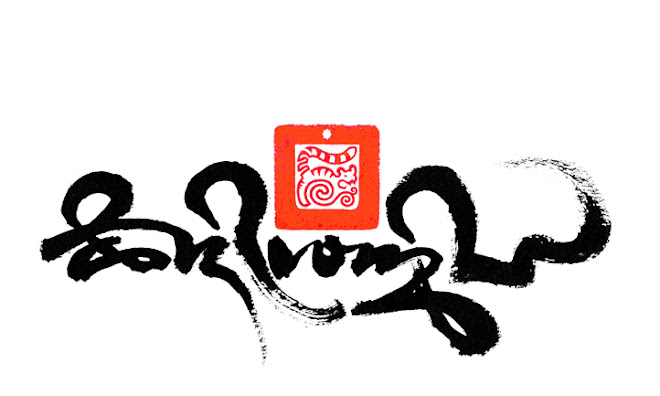Thönmi Sambhota Thangka description
This is a traditional thangka* painting, which was especially commissioned
by Tashi Mannox on the rarely depicted great calligrapher and scholar Thönmi
Sambhota.
Sambhota is reputed to be a historical figure responsible for developing the foundation of
the Tibetan writing systems in the seventh century A.D, which form the basis of
the Tibetan language today. See below for the
In this thangka, Thönmi Sambhota is shown as the main figure wearing
traditional attire of a Tibetan layperson, though wears a white turban in
reference to his many years spent in Northern India studying chiefly Sanskrit with
Brahmins and Pandits.
He holds in his lap a tablet inscribed with a rendition of a Mani
mantra, oṃ
maṇipadme hūṃ, which was presented to Dharmaraja King Songtsen Gampo as the first
sample he created of the Tibetan Uchen script. The original writing of this
mantra was carved on a rock in Rigsum Gompo temple in central Tibet, which was
unfortunately destroyed during the Cultural Revolution.
On a table before Sambhota are laid out calligraphy implements such as
ink and bamboo pens, cut from the bamboo grove behind him. Tibetan manuscripts
also sit before and behind referring to Sambhota’s scholarly achievements and
the Tibetan grammar and punctuation he composed.
Emanating from Sambhota on rainbow beams are two golden disks marked
with the letter Aa ཨ the last letter of the Tibetan alphabet, which is also
considered the essence and expression of the entire alphabet in one. On the left is Aa ཨ in the classical Uchen
script and on the right is the same letter Aa ཨ in the Umed class of scripts.
These represent the two main groups of script styles he created and still in
use to the present day.
The thangka painter Sahil Bhopal entrusted Tashi to personally add the two principle
letters Aa ཨ to the golden disks, as well as the Mani mantra within the thangka.
 To Sambhota’s below right is a student in practice of calligraphy. While
above is a scene of nature, more typical of the Karma Gadri style of thangka
painting, with trees and a cascading waterfall bringing prosperity.
To Sambhota’s below right is a student in practice of calligraphy. While
above is a scene of nature, more typical of the Karma Gadri style of thangka
painting, with trees and a cascading waterfall bringing prosperity. In the far distance are five mountains of Manjushri, the deity of learning, or can also represent the five Wisdom Buddha families.
In the sky above is Sakymuni
Buddha, who crowns Thönmi Sambhota representing his Buddhist belonging, and
motivation to benefit all.
*Tibetan thangka painting
is one of the great arts of Asia. A particular stylistic development of
painting in natural mineral media, normally on cloth which is mounted in a
brocade frame, designed to role up as a portable scroll.
Thangkas are typically rich
in iconography of their religious content that communicate the highest Buddhist
ideals, often as a visual aid to be meditated upon or to depict historical
figures and spiritual events. For a Tibetan Buddhist, thangkas are considered inspirational
sacred paintings in their physical support to a practitioner as an embodiment
of enlightenment.
History of the Tibetan Writing System
It was during the seventh century reign of Tibetan King Songtsen Gampo,
and under his direction, that the first iteration of what would become the
modern day Tibetan written language came into existence. Prior to this Tibetans
had used Mayig, a comparatively
rudimentary system. But Songtsen Gampo was faced with the task of translating
the wealth of existing Buddhist Sanskrit texts into Tibetan, and needed a
coherent writing system with sufficiently rich symbolism. He turned to minister
and great scholar, Thönmi Sambhota, who along with sixteen other wise ministers
travelled to India to study Sanskrit. Only Sambhota would return suitably
qualified. His journey had proved fruitful, however, and a new Tibetan writing
system, based loosely on Indic Sanskrit was established. It is worth noting
that the Tibetan spoken language remained the same; only written language was
renovated. Sambhota had conceived an alphabet and standardised writing
conventions, including grammar and punctuation, and would later also produce
the first iteration of both the Uchen and Umed forms.
Different script styles developed over the next several hundred years.
In the early ninth century the Tibetan script underwent another transformation
and ‘Old Tibetan’ was standardised to ‘Classical Tibetan’. One thousand years
passed, yet Tibetan calligraphy persevered, steadily evolving towards its
contemporary form. By the nineteenth century the models of Uchen and Umed, the
two main Tibetan script styles, had ossified and bore the exact
proportions still in use today.
Tibetan Calligraphy
& Tibetan Buddhism
From the offset, then, a notable bond existed between the Tibetan
writing system and Buddhism – its creation being motivated primarily by a need
to conserve and decipher Sanskrit Buddhist manuscripts. To limit calligraphy
and Tibetan Buddhism (and by association Tibetan culture’s) connection to
simply a functional conception, however, does not do justice to their
relationship. The two are largely inseparable and have remained so to the
present day. Tibetan Buddhism is considered a ‘live’ tradition, comprised of
many lineages in which a master will impress the totality of a line’s knowledge
on a disciple. The lineage is also considered fluid, as the disciple then
realises the wisdom of these teachings through meditation. Clearly, the
academic and meditative aspects of Tibetan Buddhism are closely linked.
Calligraphy’s role in this relationship as a key by which existing Buddhist
teachings are unlocked compounds its status. Developing a written language
certainly also had administrational benefits for the empire, with its use in
legal and historical documents.
-Luke Purdye











